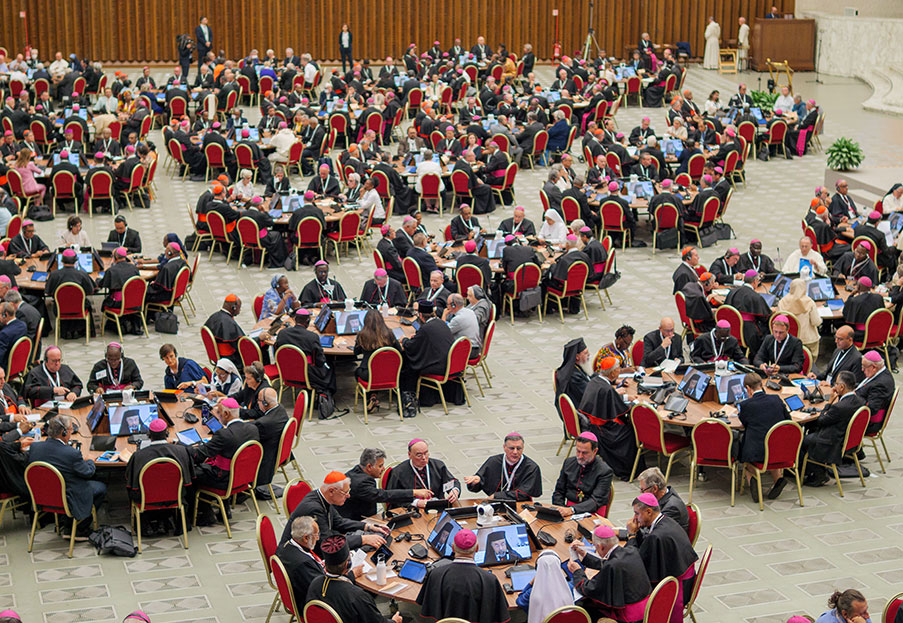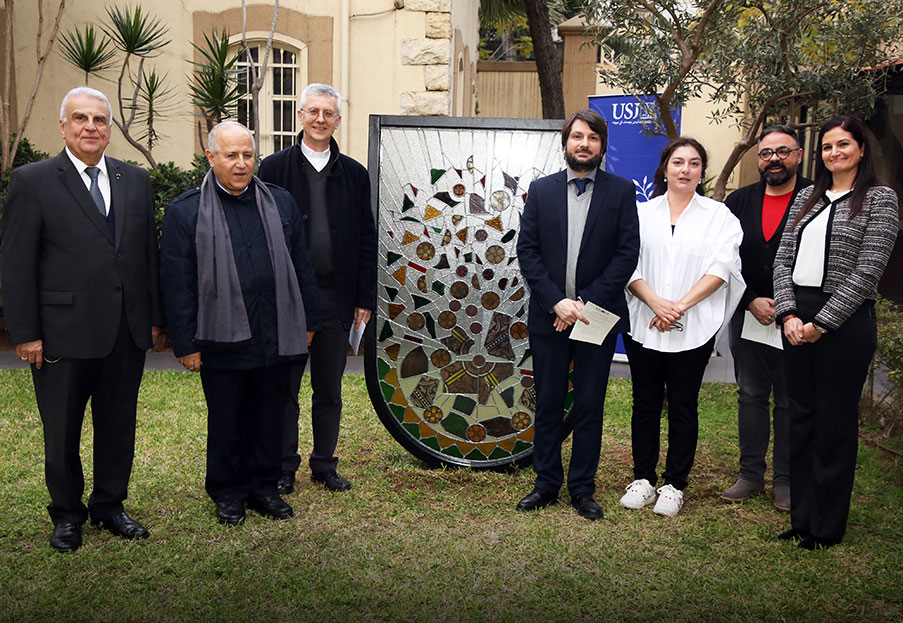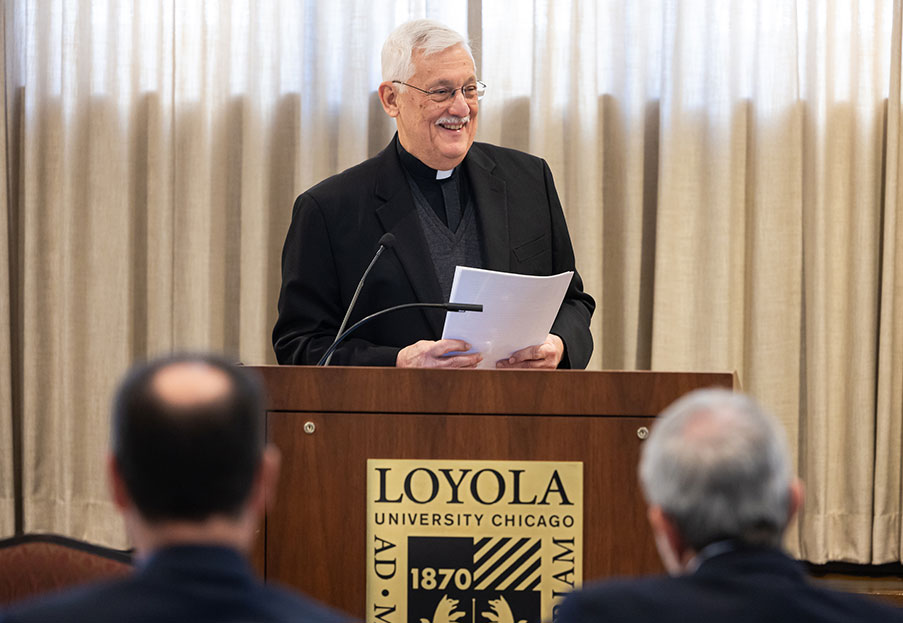On the Holy Name of Jesus
By Jean-Paul Hernández SJ
On 3 January, the Society of Jesus celebrates the titular feast of the "Holy Name of Jesus". We have asked Fr. Jean-Paul Hernández SJ, theologian, to explain the biblical roots of this feast and its importance for the Jesuits.
In the Jewish tradition, the name of God cannot be pronounced because to say the name of someone is already to make him present, to define him, in some way to possess him; and God can neither be defined nor possessed. Even today the four letters that make up the Holy Name (יְהוָֽה) are not pronounced according to their phonetic form ("Yahweh") but are replaced while reading by the words "Adonai" ("Lord"). In this way the in-finite identity of God is preserved.
But precisely because this Name cannot be pronounced, it has, like a sort of "obsessive taboo", given rise to an endless series of attempts to express it without ever pronouncing it. The Psalms are a significant example, but we can say that the whole of Holy Scripture is a "circumlocution of the Name of God". The "Name" is like the eye of a "cyclone of creativity" that also gave birth to Israel's feasts, its customs, and ultimately its very history. The very word "Judea" comes from the root "jada" which means to invoke, proclaim, confess. The implicit object is evidently the Name of God. Israel is the people whose identity consists precisely in proclaiming the Holy Name. That is why God often calls Israel in the Hebrew Bible "people marked with my Name". We could say: Israel exists to proclaim the unutterable Name of God.
Chapter 3 of Exodus relates how God reveals his name to Moses: "I am He who is". (Hebrew: "Hehye asher hehye"). This expression sounds like a kind of "non-name" or even a refusal to be named. It is as if God had said: I am "totally Other" and therefore do not have a name like other names; my identity is not "circumscribable" in a sound, describable by a name, but is identical only to itself.
At the same time, the Hebrew root that we translate as "I am" is the root that indicates "fidelity". It is not an "I am" of a "philosophical" type, as it has sometimes been interpreted in the Christian West. It is not "I am being" or "I am the metaphysical root of existence". But rather: "I am there", or "I am the one who is always with you", who "is there". The Name of God, his most intimate identity, is the capacity to make himself present, to be with. So the self-delivery of the Name coincides with its very meaning. We could say: God hands over his own identity which consists in handing over his own identity.
It is again on Sinai that God makes his Name more explicit to Moses, who now leads all the people: "Then the Lord came down in the cloud and stood by him and proclaimed the Name of the Lord. The Lord passed by him proclaiming: "The Lord (יְהוָֽה), the Lord (יְהוָֽה), the compassionate and gracious God, slow to anger and abounding in love and faithfulness" (Ex 34:5f.). These last "affixes" to the Tetragrammaton form like a first circle around the inaccessible eye of the "creative cyclone" of the Name of God. They are attempts to "say who God is", but already only partial attempts. The Hebrew words are, "rhm" which we translate as "compassionate" but which refers to the "maternal bowels", "hen" which describes the gesture of looking out and which we can translate as "benevolent" or "pitiful", "hesed" which we translate as "grace" and which is also compassion and goodness in a relationship, and "emet" which means "fidelity", "truth", "honesty".
But this Name cannot be pronounced "in vain", that is, it can only be pronounced with one's life. In the struggle with God described in Gen 32, Jacob had asked the mysterious presence: "Tell me your name!" (Gen 32:30). The divine answer was, "And here he blessed him". Jacob emerges radically changed from this encounter with God from whom he had wanted to "snatch" the "Name". In fact, Jacob came out with a new name: "Israel". We can say: the Name of God is the only name that changes the identity of those who pronounce it.
In the history of Israel, this name may be pronounced once a year by the high priest who enters during "Yom Kippur" (the liturgical day of "expiation", that is of "forgiveness") into the "Debir" ("holy of holies") of the Temple. In front of the ark he pronounces the Tetragrammaton, the letters of which are preserved inside the ark. And from the empty space between the two cherubim above the ark, God, made present by the pronounced Name, answers. Thus the entire temple is repeatedly described in the Bible as "the place He chose for His Name to dwell". God somehow "dwells" in the Temple through his Name which is a kind of "hypostatic presence" of God. But this same name is also for Israel the "figure" of all creation: "O Lord, our God, how great is your name in all the earth" (Ps 8:2:10). Therefore, the Temple represents "the whole world", ordered around the Name.
If the Name of God is the faithful presence of God, the revelation of God's very identity, and at the same time the figure of the whole of creation, we should not be surprised that early Christianity attributed to Jesus Christ all that Israel had attributed to the "Name". In an anonymous homily of the second century we read: "Now the Name of the Father is the Son". And already in the Gospel of John, all the words of Jesus that begin with "I am" are an allusion to the Name of God, revealed by Jesus in his different actions as in the different facets of a prism.
In the Letter to the Philippians we have a fundamental passage that will mark Christian spirituality forever. Paul in chapter 2 is quoting a Christological hymn that recalls the Resurrection of Christ with the metaphor "give him the name that is above every other name" (Phil 2:9), which means "give him the name of God", that is, the identity of God. It is a way of saying: in the Resurrection the divine identity of Jesus is revealed. But the text continues (v. 10): "because in the name of...". And here the reader expects to find the word "God", or "Lord" (which is precisely the "name above every other name"). Instead, the surprise is that here we read "...Jesus" (and then the text continues with "let every knee bend, in heaven, on earth and under the earth"). The text thus operates a surprising translation of meaning from the name "Adonai" to the name "Jesus". Everything that the name of God has always meant and provoked, the name "Jesus" now does.
This name given to Mary's son was already a
common name among the people of Israel. Biblical tradition recalls in
particular Jesus Ben Sirach (the "Sirach"), emblem of Wisdom, and
Joshua, successor of Moses. The two figures converge in Jesus of Nazareth, who
for the New Testament is Wisdom incarnate and the fulfilment of the work of Moses.
It is easy to understand then how in the Acts of the Apostles, Peter says, "for there is no other name under heaven given to men by which we may be saved" (Acts 4:12). In the use of the verb "to save" there is an explicit reference to the Hebrew meaning of the name of Jesus (Jeshua) which means precisely "God-saves". Therefore, the name of Jesus is already in itself a prayer of invocation and/or thanksgiving. The tradition of the "Name Prayer", that is, the constant repetition of the name of Jesus, or of an invocation formula containing it, dates back to the earliest centuries. The invocation "Lord Jesus, Son of the living God, have mercy on me, a sinner", and its variants, are called the "prayer of the esichia", i.e. of "peace of heart".
Also in the liturgical tradition of the first centuries, it is "in the Name of Jesus" that catechumens are "baptised" and the mysteries are celebrated. When the book of Revelation points out that the saved wear "the name of their God" on their foreheads (cf. Rev 14:1 and 22:4), it is probably already referring to the liturgical custom of "marking" the baptised with an "X", the first Greek letter of "Christos". Straightened out, it also draws a cross. This led to the frequent identification of the name and the cross, which allowed the liturgical and artistic tradition (e.g. with the "staurogram") to say that the true place where Christ reveals his name, i.e. his identity, is the cross.
It was in the late Middle Ages that the spirituality of the Name of Jesus developed in the West. First of all in the Franciscan sphere, thanks to the preaching of St Bernardine. The saint from Siena chose the three first Greek letters of the name of Jesus, IHS, to develop devotional objects that were to replace the heraldic controversy of families. This 'trigram' was already the abbreviation of 'IHSOUS' in the manuscripts of the New Testament, where the copier superimposed a tilde or a wavy hyphen, precisely to indicate that 'IHS' was an abbreviation. When, from the 10th century onwards, Greek manuscripts became lower case, the hyphen above the ihs intersected the vertical shaft of the "h", forming a cross. The interlacing of Name and cross is thus recovered.
It is this type of "trigram-cross", often surrounded by sunrays, that arrives from central Italy to other parts of Western Europe. And it was in Paris that Calvin and St Ignatius encountered it. The former made it the coat of arms of "his" city of Geneva. The latter began to use it to sign his letters. Later on, the IHS will become the symbol of the Society of Jesus. In addition to its Greek meaning, it can also be understood as the Latin abbreviation for "Iesus Hominum Salvator" (Jesus Saviour of Men). In a single symbol, therefore, a Greek, Latin and Jewish perspective converges (cf. "Salvator"). The cross on the "H", now also in capitals, always links Name and Cross, and the three nails often represented below recall the passion of Christ, but also the three religious vows of poverty, chastity, and obedience.
If Ignatius and the early Jesuits were able to
identify with this symbol it is because they had chosen to call themselves
companions 'of Jesus' and not 'Ignighists' (after Ignatius) or something else.
It is the very person of Jesus, His "Name," that is, His
"communicated identity," that inflamed Ignatius' heart, that is the
focus of the Exercises, that unites the first companions, and that is meant to
be the only "word" of the Society. It is, as the Formula of the
Institute says, "designated by the Name of Jesus". Hence the IHS is
ubiquitous in Jesuit art, in official documents and still today in many of the
"logos" used by the Society. As the early Jesuits repeated, this Name
"is more beautiful than dawn and light" and "we Jesuits must be
ready to give our blood for this name".










